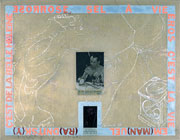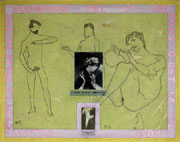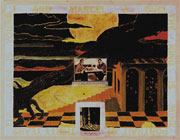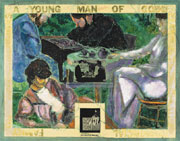|
These six paintings
linking Marcel Duchamp and Man Ray are part of a long-term project
on art, artists and art movements. The Duchamp/Man Ray paintings are
pairs or companion pieces. The paintings, in gouache, are not absolutely
faithful to detail or color and are painted with flat surfaces and
thin paint so as not to reproduce the texture of the originals. The
series began late in 1995. It was completed in early 2000 with nineteen
paintings.
The work is in various
paint media-gouache, acrylic, oil-acrylic gel transfer photocopies
and computer-generated type. While each pair of paintings carries
intellectual and personal content, their primary impact is visual.
The block letter
texts framing the images are gleaned from various sources; they are
pertinent to the images and are combinations of artist's titles and
descriptions as well as observations from critics, historians and
curators, and others.
Some of the artists
have influenced me or been a source of inspiration. Others' work uses
motifs and backdrops for intertextual discourse. Each pair has a Jewish
context or presence. The Jewishness is represented by my selection
of artists, critics, and historians. The paintings are personal responses
to specific aesthetics, works of art, artists, art movements, art
personalities, and my own social, aesthetic, or political engagement
with them.
In this century,
copying, can be found in the work of Pablo Picasso, Roy Lichtenstein
and Sherrie Levine. Picasso abducted other sources because he needed
icons as sources of inspiration; Lichtenstein carried away various
modernist pictures to praise and subvert them for his popular comic
book style and Levine deconstructed modernist paradigms in her "stainless
steals." Unlike Picasso, I am not pilfering images; unlike Lichtenstein,
I am not re-designing paintings to convey a post-modern aura; and
unlike Levine, I am not re-writing history. But more like the poster
paintings of Charles Demuth, on the other hand, which were tributes
to his friends and associates, this work is largely about late modernism,
artists and critics and their complicated inter-personal associations.
The written material,
aside the paintings, augments the narrative I tell in pictures and
words:
Paintings 1 & 2, 1997-1998 (44"x34")
| Click
to enlarge |
 |

|
 Left Panel: ADOPTED
BY THE FRENCH/PAINTING WITH LIGHT/OUR OWN MAN RAY/BROKEN WITH SIGHT Left Panel: ADOPTED
BY THE FRENCH/PAINTING WITH LIGHT/OUR OWN MAN RAY/BROKEN WITH SIGHT
The
background image is a painted copy of Man Ray's The Rope Dancer
Accompanies herself with her Shadows, 1916. This painting was
completed while Marcel Duchamp was working on his Large Glass; it
is in homage to or, at least, is an allusion to Duchamp's work. The
central photocopy is a Man Ray self-portrait photograph with a camera.
His quote reads: "I tell them that the tricks of today are the truths
of tomorrow." The photocopy in the lower center is a photograph of
the lower portion of The Bride Stripped Bare by Her Bachelors,
Even by Man Ray and Marcel Duchamp's Dust Breeding, 1920.
 Right panel: WELCOME
TO NEW YORK/BROKEN WITH SIGHT/ENIGMATIC DUCHAMP/ANTI RETINAL ART Right panel: WELCOME
TO NEW YORK/BROKEN WITH SIGHT/ENIGMATIC DUCHAMP/ANTI RETINAL ART
The background image
is a painted copy of Duchamp's drawing for the Large Glass.
The central photocopy is a photograph of Duchamp by Man Ray. His quote
reads: "It is idle to explain it, I do not explain it. It is, after
all, the fourth dimension." The photocopy in the lower center is the
lower portion of the Large Glass photographed by Charles Scheeler,
c. 1921.
Text around these
paintings was gleaned from what the artists said and what others said
about them. "WELCOME TO NEW YORK," is from a Francis Picabia painting
completed shortly after he made his first visit to the city and encouraged
Duchamp to follow.
Duchamp, a son of
a French notary, and Man Ray, born of immigrant Jews in Philadelphia,
were friends and partners in art and chess since they met in New Jersey
in 1915 where they feigned an imaginary game of tennis. Perhaps this
was the first work of Performance Art. They shared interests in Dada,
machine-like contrivances, cross-dressing, women, sex and readymades,
as well as chess, for over fifty years.
Paintings 3 & 4, 1998 (44"x34")
| Click
to enlarge |
 |

|
 Left Panel: ...ROSE SEL A VIE/EROSE C'EST LA VIE/EM(MAN)UEL (RA)DNITSK(Y)/C'EST
DE LA BELLE HÆLEINE
Left Panel: ...ROSE SEL A VIE/EROSE C'EST LA VIE/EM(MAN)UEL (RA)DNITSK(Y)/C'EST
DE LA BELLE HÆLEINE
The background images
are painted copies of Man Ray drawings: the left side drawing was
done from a photograph of Man Ray's wife, Julie in 1942; the right
side is a surrealist drawing, Sablier-compte fils [(the) Hourglass
Counts (the) Threads, (probably another reference to the
bride stripping bare)], 1938. The central photocopy is a self-portrait
photograph in which Man Ray depicts himself about to indulge in multiple
suicides. His quote reads: "To Be-continued unnoticed." The photocopy
lower center is a magazine reproduction of a solarized print with
color: Beauty in Ultra Violet, 1940.
 Right Panel: ...ROSE SEL A VIE/EROS C'EST LA VIE/RROSE SELAVY/C'EST
LA BELLE HELENE
Right Panel: ...ROSE SEL A VIE/EROS C'EST LA VIE/RROSE SELAVY/C'EST
LA BELLE HELENE
The background images
are painted copies of Duchamp's etchings. The left side is from Lucas
Cranach's Adam and Eve from a presentation, years before, with
Duchamp on stage as Adam and Bronia Perlmutter as Eve in a Ciné
Sketch produced by Francis Picabia and René Clair at the Théâtre
des Champs-Elysées. The right side is from a painting by Gustav Courbét-this
is the bride stripping bare; the falcon represents a "peeping
Tom" bachelor and "a false cunt and a real one," according to Duchamp.
The central photocopy is a photograph of Duchamp as Rrose Selavy-his
alter ego Jewish woman persona. His quote reads: "...I consider myself...'an
unfrocked artist.'" The photocopy lower center is Duchamp's relief
maquette, painted leather over a plaster mounted on velvet, for Etant
donné: Given the Illuminating Gas and the Waterfall, 1948-'49.
Multiple puns abound
in the text: Man Ray's, "...ROSE SEL A VIE (originally a Rayograph
Dadist object portrait of Duchamp published in The little Review,
1922) translates to "ROSE THE SALT OF LIFE," Duchamp's French enunciation,
EROS C'EST LA VIE, is "EROTICISM THAT'S LIFE," and his English transliteration
of RROSE SELAVY is "ROSE LEVY." Other puns revolve around the perfume
bottle readymade with a photograph portrait of Duchamp as a woman
wearing a hat (not shown) called "C"EST DE LA BELLE HÆLEINE-BEAUTIFUL
BREATH." (I superimposed the "A" over the "E" to make the pun on "HALEINE"
more closely resemble "HELENE." "C'EST DE LA BELLE HELENE-BEAUTIFUL
HELEN," which is my addition to the punster game.
Paintings 5 & 6, 1998 (44"x34")
| Click
to enlarge |

|

|
 Left Panel: I AND MARCEL A DUEL/THE KING IS MINE/PORTRAIT OF THIRTY
YEARS/THE QUEEN IS YOURS (This is to be read horizontally top and
bottom and vertically right and left.)
Left Panel: I AND MARCEL A DUEL/THE KING IS MINE/PORTRAIT OF THIRTY
YEARS/THE QUEEN IS YOURS (This is to be read horizontally top and
bottom and vertically right and left.)
The background image
is a painted copy of Man Ray's Night Sun-Abandoned Playground,
1943. The central photocopy is a photograph of Man Ray and Duchamp,
as old men, playing chess. His quote reads: "The Cosmic Urge-with
ape-ologies to PicASSo, 1915." The photocopy lower center is Man Ray's
whimsical construction of a chess board with three giant chess pieces,
Permanent Attraction, 1948
 Right
Panel: A YOUNG MAN OF GOOD/ELEMENTARY TREATICE/ PROVINCIAL/FAMILY/ON
FOUR-DIMENSIONS (This is to be read horizontally top and bottom and
vertically right and left.) Right
Panel: A YOUNG MAN OF GOOD/ELEMENTARY TREATICE/ PROVINCIAL/FAMILY/ON
FOUR-DIMENSIONS (This is to be read horizontally top and bottom and
vertically right and left.)
The background
image is a painted copy of Duchamp's The Chess Game, 1910,
which includes his two artist brothers playing chess and his sisters
sitting around. The central photocopy is of a photograph of Man
Ray and Duchamp, as young men, playing chess. His quote reads: "A
piece of canned chance. It's amusing to put chance in a can," 1913-1914.
The photocopy lower center is of Duchamp's construction, "Pocket
Chess set with Rubber Glove," 1966, upside down.
The mysteries of
chess, plays on words, games, chance, physics and mathematics were
mutual interests of these perplexing artists.
|